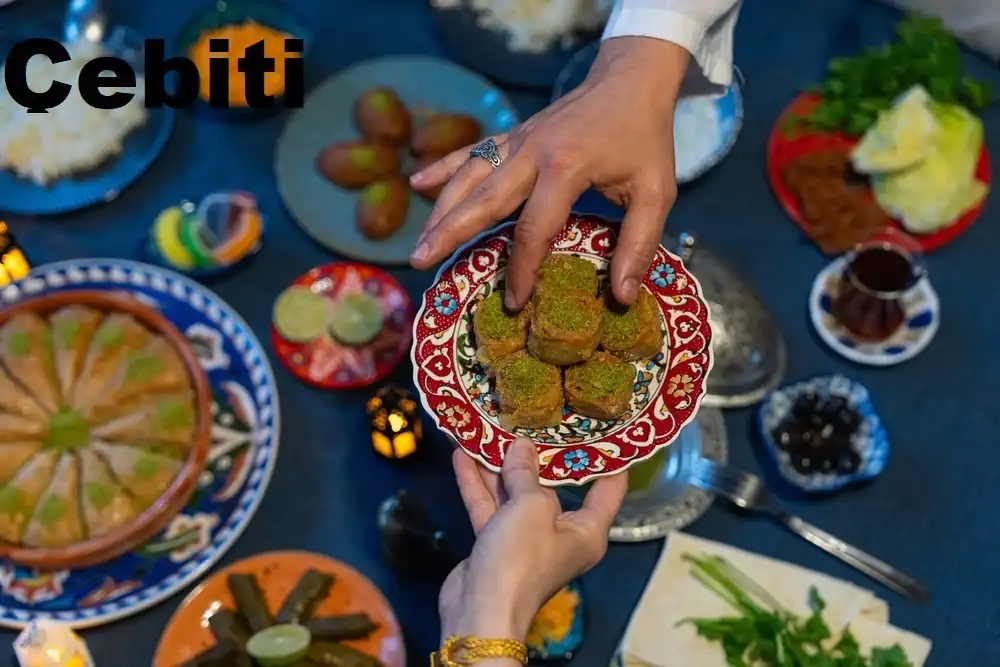Çebiti: A Delectable Journey Through Turkish Culinary Heritage

Çebiti, a traditional Turkish dessert, is more than just a sweet treat; it is a testament to centuries of culinary innovation, cultural exchange, and gastronomic evolution. From its ancient roots in Anatolia to its refinement during the Seljuk and Ottoman periods, çebiti encapsulates the rich heritage and diverse influences that have shaped Turkish cuisine. This article explores the historical journey, key ingredients, preparation methods, and cultural significance of çebiti, inviting readers to discover the magic of this timeless dessert.
Ancient Origins
The origins of çebiti can be traced back to ancient Anatolia, a region renowned for its contribution to civilization and gastronomy. Nestled in the fertile crescents of Mesopotamia, Anatolia was a cradle of early agriculture and culinary experimentation. Archaeological excavations reveal that the inhabitants of ancient Anatolia had a penchant for sweets, crafting delectable concoctions from honey, nuts, and fruits—precursors to the çebiti we know and love today.
Early Sweet Concoctions
In ancient Anatolia, honey was a primary sweetener. The region’s rich flora provided ample nectar, which bees transformed into honey, a prized commodity in early societies. Combined with locally available nuts like almonds and walnuts, and dried fruits such as figs and dates, ancient Anatolians created early versions of sweet dishes. These primitive desserts laid the groundwork for the sophisticated confectioneries that would emerge in later periods.
Influence of Trade and Cultural Exchange
Anatolia’s strategic location at the crossroads of East and West facilitated cultural and culinary exchanges. Trade routes like the Silk Road brought new ingredients and culinary techniques to the region. Spices from the East, such as cinnamon and cardamom, began to feature in local recipes, enriching the flavor profiles of Anatolian sweets. This early fusion of local and exotic ingredients set the stage for the development of distinctive Turkish desserts, including çebiti.
Medieval Influence
The evolution of çebiti took a significant turn during the medieval period, under the influence of the Seljuk and Ottoman empires. These powerful dynasties not only expanded territories but also culinary horizons, introducing an array of flavors and ingredients to the Turkish palate. Çebiti emerged as a symbol of opulence and hospitality, featured prominently at royal banquets and celebrations. The sweet’s intricate blend of flavors and textures quickly endeared it to both common folk and aristocracy alike.
The Seljuk Empire
The Seljuks, who ruled over Anatolia from the 11th to the 13th centuries, played a crucial role in shaping Turkish cuisine. They brought with them a rich culinary heritage that blended Central Asian, Persian, and Arab influences. This period saw the introduction of new cooking techniques and ingredients, which were readily incorporated into local traditions. The Seljuk influence on çebiti can be seen in the use of ingredients like rose water and the emphasis on elaborate presentation.
The Ottoman Empire
The Ottoman Empire, which succeeded the Seljuks, further enriched the culinary landscape of Anatolia. Spanning three continents and ruling for over six centuries, the Ottomans absorbed and integrated diverse culinary traditions from their vast territories. Çebiti became a staple at the Ottoman court, where it was refined and perfected. The use of high-quality ingredients, meticulous preparation methods, and artistic presentation elevated çebiti to a symbol of imperial luxury.
Key Ingredients of Çebiti
The allure of çebiti lies in its carefully curated ingredients, each contributing to the sweet’s rich flavor profile and delightful texture. Below, we explore the essential components that make çebiti an unforgettable treat.
Semolina
At the heart of çebiti is semolina, the coarse flour made from durum wheat. Semolina’s unique granular texture and slightly nutty flavor form the backbone of the dough, providing the perfect balance between lightness and density. Its versatility makes semolina an ideal base for experimenting with various flavors and additives, allowing çebiti to transcend its traditional boundaries.
Sugar
No exploration of çebiti would be complete without acknowledging the role of sugar. Integral to achieving the sweet’s signature sweetness, sugar can be incorporated directly into the dough or used as a syrupy coating. The crystalline sweetness of sugar elevates çebiti, making it a decadent confectionery delight.
Butter or Clarified Butter (Ghee)
Butter, or its clarified counterpart ghee, is used to enrich çebiti’s dough, lending it a luxurious buttery aroma and silky texture. Whether melted into the dough or brushed atop the sweet before baking, butter ensures that each bite of çebiti melts sumptuously in the mouth.
Milk
Milk acts as a cohesive element in çebiti dough, ensuring a consistent and tender crumb. Its creamy properties enhance the overall flavor, adding a subtle sweetness that harmonizes with the other ingredients. Milk’s versatility also allows for variations in texture and richness, making each iteration of çebiti a unique culinary experience.
Rose Water or Orange Blossom Water
To imbue çebiti with an aromatic flourish, traditional recipes often incorporate rose water or orange blossom water. These fragrant liquids infuse the sweet with a delicate floral scent, elevating the sensory experience of enjoying çebiti. The use of these aromatic waters is a nod to the Middle Eastern influences that have shaped Turkish cuisine, adding depth and complexity to this timeless treat.
Preparation and Techniques
The preparation of çebiti is both an art and a science, requiring careful attention to detail and a mastery of traditional techniques. The process involves several key steps, each contributing to the final product’s exquisite taste and texture.
Making the Dough
The foundation of çebiti is its dough, made primarily from semolina, sugar, butter, and milk. The semolina is first toasted in melted butter until it turns golden brown, releasing a nutty aroma. This step is crucial as it enhances the flavor and texture of the dough. Sugar is then added, followed by milk, which is gradually incorporated to form a smooth, cohesive mixture. The dough is kneaded until it reaches the desired consistency, ensuring that the semolina grains are evenly distributed.
Flavoring and Shaping
Once the dough is prepared, it is flavored with rose water or orange blossom water, which imparts a delicate floral aroma. The dough is then shaped into small, bite-sized pieces, often using traditional molds or by hand. The shaping process allows for creativity, with various designs and patterns reflecting regional styles and personal preferences.
Baking
The shaped dough pieces are placed on a baking tray and baked until they achieve a golden-brown color. The baking process is carefully monitored to ensure even cooking and to prevent the sweets from drying out. The result is a batch of perfectly baked çebiti, each piece boasting a tender crumb and a rich, buttery flavor.
Finishing Touches
To complete the preparation, the baked çebiti pieces are often coated with a light syrup made from sugar and water. This syrup adds a glossy finish and an extra layer of sweetness, enhancing the overall taste. Alternatively, the sweets can be dusted with powdered sugar or garnished with crushed nuts, adding visual appeal and additional texture.
Cultural Significance
Çebiti is more than just a dessert; it is a cultural artifact, embodying centuries of Turkish culinary tradition and innovation. Its enduring popularity is a testament to the universal appeal of sweets that connect us to our past while continuing to evolve. Whether served at festive occasions, religious celebrations, or family gatherings, çebiti holds a special place in Turkish culture.
Symbol of Hospitality
In Turkish culture, hospitality is highly valued, and offering sweets to guests is a common practice. Çebiti, with its rich flavors and beautiful presentation, is often served to guests as a gesture of warmth and generosity. It is also a staple at celebrations such as weddings, festivals, and religious holidays, symbolizing joy and abundance.
Preservation of Tradition
The preparation and enjoyment of çebiti are deeply rooted in tradition. Recipes and techniques are often passed down through generations, preserving the cultural heritage associated with this beloved dessert. In many families, making çebiti is a communal activity, bringing together relatives to share in the joy of creating and savoring this sweet treat.
Culinary Innovation
While çebiti remains true to its traditional roots, it has also evolved to reflect contemporary tastes and dietary preferences. Modern variations include vegan and gluten-free versions, allowing more people to enjoy this classic dessert. The adaptability of çebiti ensures its continued relevance in Turkish cuisine and beyond.
FAQs (Frequently Asked Questions)
What is çebiti, and how is it different from other Turkish desserts?
Çebiti is a traditional Turkish dessert made mainly from semolina, sugar, butter, and milk, with a hint of rose or orange blossom water for extra flavor. Its special texture and these specific ingredients make it different from other Turkish treats.
Can çebiti be made vegan?
Yes, çebiti can be adapted for a vegan diet by substituting dairy ingredients with plant-based alternatives and using vegan sugar. For example, almond or soy milk can replace cow’s milk, and vegan butter can be used instead of traditional butter.
Is çebiti gluten-free?
Traditionally, çebiti is not gluten-free as it is made with semolina, which contains gluten. However, gluten-free flours, such as rice flour or almond flour, can be used as an alternative to make it suitable for those with gluten sensitivities. The texture and flavor may vary slightly, but the essence of çebiti can still be enjoyed.
How long does çebiti last?
When stored properly in an airtight container, çebiti can last up to a week at room temperature and longer if refrigerated. To maintain its freshness and texture, it is recommended to keep çebiti in a cool, dry place, away from direct sunlight. If refrigerated, it can last up to two weeks, retaining its delightful taste and texture. For the best experience, bring it to room temperature before serving, allowing the flavors and aromas to fully develop.
Wrap Up
Çebiti is more than just a dessert; it is a cultural gem, reflecting centuries of Turkish culinary tradition and innovation. From its ancient origins in Anatolia to its refined presence in royal Ottoman kitchens, çebiti has evolved into a beloved treat enjoyed by many. Its unique combination of semolina, sugar, butter, milk, and aromatic waters sets it apart from other Turkish sweets, offering a delightful sensory experience. Whether you’re a seasoned food enthusiast or new to Turkish cuisine, çebiti provides a tantalizing taste of Turkey’s rich gastronomic heritage. We invite you to savor the flavors of çebiti and appreciate the historical and cultural journey encapsulated in each bite.






